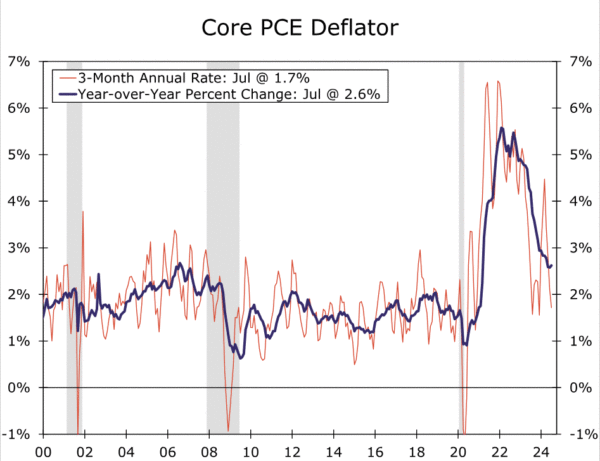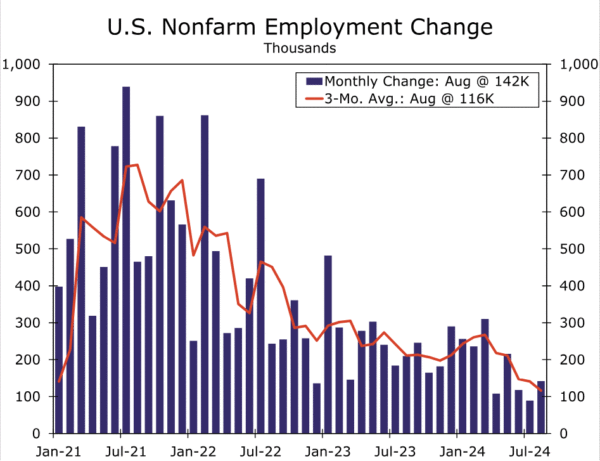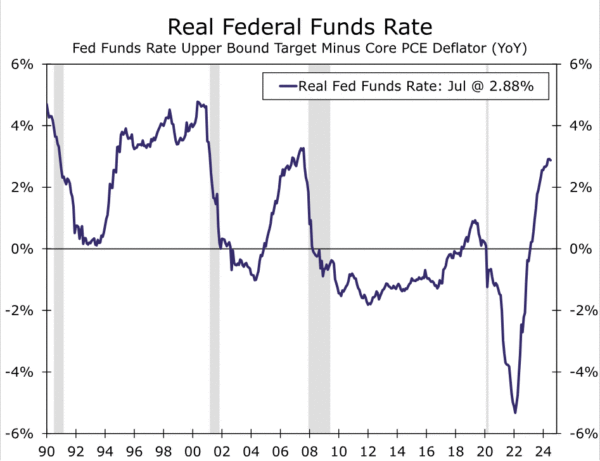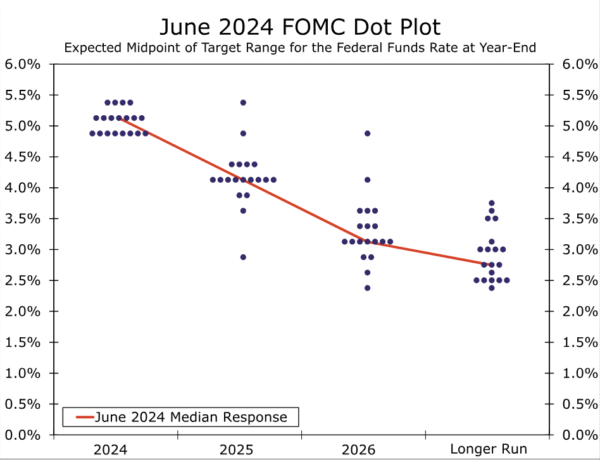Summary
- Data released since the last FOMC meeting on July 31 make a compelling case for the Committee to begin easing the stance of monetary policy at its upcoming meeting on September 18. Inflation remains a bit above the Fed’s target of 2%, but momentum in consumer prices clearly is slowing. Meanwhile, the labor market, the other half of the Fed’s dual mandate, has softened.
- As stated by Fed Chair Jerome Powell, “the time has come for policy to adjust.” The only question is the magnitude of the rate cut on September 18. Will the FOMC cut rates by 25 bps or sanction a 50 bps reduction?
- We expect the Committee will cut rates by 25 bps at the September 18 meeting based on recent remarks from Fed officials indicating that most favor a go-slow approach at this juncture. That said, some notable Fed officials, including FOMC Chair Powell and Vice Chair Williams, have refrained from commenting on how large a reduction may be warranted in the near term, keeping the door open to a larger cut in September. Therefore, we would not be totally surprised if the FOMC opted for a 50 bps rate cut instead.
- We look for the median dot in the dot plot to shift down by 50 bps to 4.625% for year-end 2024, indicating the median participant thinks another 50 bps of rate cuts after the September meeting will be appropriate by the end of the year. For 2025, we expect the median dot to fall to 3.375%, implying 125 bps of additional easing next year.
- We think that the run of 17 consecutive FOMC meetings without a dissent may be broken at this meeting. If, as we expect, the FOMC cuts rates by 25 bps, then we can envision more dovish voting members of the Committee potentially dissenting in favor of a larger reduction. Conversely, if the FOMC opts for a 50 bps rate cut, then hawkish voting members could dissent, preferring a 25 bps rate reduction instead.
“The Time Has Come for Policy to Adjust”
Data released since the last FOMC meeting on July 31 make a compelling case for the Committee to begin cutting the federal funds rate at its upcoming meeting on September 18. For starters, inflationary pressures continue to subside. Although the year-over-year change in the core PCE price index, which Fed policymakers believe is the best measure of the underlying rate of consumer price inflation, remains above the central bank’s target of 2%, momentum in consumer prices is slowing. The index rose at an annualized rate of only 1.7% between April and July, down sharply from the 4.5% annualized rate of change that was registered between December and March (Figure 1). In short, the FOMC has made additional progress recently in fulfilling the “stable prices” component of its dual mandate.
Turning to the other side of the dual mandate, the risks to “maximum employment” are rising. Although payrolls rebounded in August with a 142K monthly gain, up from only 89K in July, the underlying pace of job creation clearly has downshifted. Whereas payrolls rose at an average monthly pace of 207K in the first half of the year, the economy created only 116K jobs per month on average between June and August (Figure 2). Furthermore, the unemployment rate has trended up from 3.7% at the turn of the year to 4.2% in August. Softening in labor market conditions should help to put downward pressure on wage gains, thereby leading to further price growth moderation in coming months. In that regard, average hourly earnings were up 3.8% on a year-ago basis in August, which represents a significant slowing from the 5.9% increase that was registered in March 2022.
With the risks to the two sides of the dual mandate becoming more skewed toward the labor market, the time to begin easing monetary policy appears to have arrived. Federal Reserve Chair Jerome Powell signaled as much in his August 23 Jackson Hole speech when he stated “the time has come for policy to adjust.” The only question appears to be the magnitude of the rate cut on September 18. That is, will the FOMC reduce its target range for the federal funds rate by 25 bps or by 50 bps?
We look for the FOMC to cut rates by 25 bps on September 18 based on our sense of the Committee’s reaction function at present. Recent remarks from Fed officials indicate most favor a go-slow approach at this juncture. For example, Federal Reserve Governor Christopher Waller, who we consider a bellwether of the Committee, said in a speech after the August jobs report that he expects cuts to be done “carefully.” Earlier in August, Fed Governor Michelle Bowman and Federal Reserve Bank of Boston President Susan Collins both indicated support for a “gradual” pace of cuts should inflation continue to ease. Philadelphia Fed President Patrick Harker noted the need to start bringing the fed funds rate down “methodically.”
That noted, other Fed officials, including FOMC Chair Powell and Vice Chair John Williams, have refrained from commenting on how large a reduction may be warranted in the near term, keeping the door open to a larger cut in September. Although not our base case view, we readily acknowledge that the Committee may opt for a 50 bps cut in light of inflation having slowed considerably and in an effort to stave off the labor market cooling beyond the point of comfort.
Regardless of the size of the rate cut at the upcoming meeting, we look for the FOMC to ease significantly in the coming months. The stance of monetary policy, which we measure by the real fed funds rate, is quite restrictive at present (Figure 3). The “neutral” real rate is unobservable, but many analysts, including us, estimate it to be in the vicinity of 1.0%-1.5%. With the real rate currently standing at nearly 3%, the FOMC needs to cut the nominal fed funds rate considerably in coming months to get back to neutral. Otherwise, Federal Reserve policymakers risk driving the economy into recession with an overly tight stance of monetary policy. We look for the Committee to cut rates by 225 bps by mid-2025.
Looking for a Downward Shift in the Dots
The quarterly Summary of Economic Projections (SEP), which aggregates the individual macroeconomic forecasts of the 19 FOMC members, will be published at the conclusion of the September 18 meeting. Notably, the last SEP, which was published following the June FOMC meeting, showed the median FOMC member thought that only one 25 bps rate cut would be appropriate by the end of this year (Figure 4). As noted above, however, the risks to the Fed’s two mandates have become evenly balanced since the publication of the last SEP, if not tilted toward the labor market in our view. Consequently, the dots for are likely will shift down. But by how much?
We expect the 2024 median dot to fall to 4.625%, implying two additional 25 bps cuts this year (after the September 18 meeting) and consistent with most officials anticipating a measured pace of rate cuts going forward. The dispersion of dots, however, is likely to be unusually wide considering the 2024 projection period will only cover the two remaining meetings of the year (November 7 and December 18). We would not be surprised to see at least one dot as low as 4.125%, and for the upper end of the distribution to indicate just 25 bps of easing this year (a dot of 5.125%).
In the June SEP, the median dot suggested participants anticipated a federal funds rate of 4.125% at year-end 2025. However, given the clear renewed progress in reducing inflation as well as the softening in the jobs market since then, we expect the median dot in 2025 to fall to 3.375%, implying 125 bps of additional easing next year. Compared to the June SEP, we think the 2026 median dot likely will sink 25 bps lower to 2.875%, closer to most participants’ estimates of neutral. The upcoming SEP also will provide projections for 2027 for the first time, and we expect the median estimate to be near participants’ estimates of the longer run federal funds rate. We do not expect the longer-run median dot of 2.75% to change at this meeting.
The dot plot will garner the most market attention, but the FOMC likely will make some changes to other parts of the SEP. In June, the median forecast for the unemployment rate at the end of 2024 was 4.0%. With the jobless rate currently sitting at 4.2%, an upward revision to that level or even a tick higher seems probable. We also think some downward revisions to inflation in the SEP for this year seem likely. We estimate the Q4/Q4 rate of headline PCE inflation this year will be 2.5% compared to the June SEP estimate of 2.6%, while core PCE inflation is likely be up 2.7%.
Dissenting Voices
Dissents by FOMC voters at policy turning points are not uncommon. For example, the FOMC decided in June 2019 to keep rates on hold for the fourth consecutive meeting. However, James Bullard, who at the time was the president of Federal Reserve Bank of St. Louis, dissented because he preferred a 25 bps rate cut. The Committee then reduced its target range for the fed funds rate at its next meeting in July, but Boston Fed President Eric Rosengren and Esther George, president of Kansas City Fed, both dissented because they wanted to keep rates on hold. A few years later, the FOMC tightened policy by 25 bps in March 2022, the first rate hike in the post-pandemic period. However, St. Louis Fed President Bullard dissented because he preferred a 50 bps increase at that meeting. The Committee accelerated the pace of tightening in June 2022 with a 75 bps rate hike, provoking a dissent by Kansas City Fed President George who preferred a 50 bps increase.
As demonstrated by the absence of dissents in the 17 meetings since the June 2022, the Committee has been more or less unified in its views regarding the appropriate stance of policy over that period. With the FOMC likely to cut rates on September 18 for the first time in more than five years, we would not be surprised to see that streak come to an end. If, as we expect, the FOMC cuts rates by 25 bps, then we can envision more dovish voting members of the Committee (e.g., San Francisco Fed President Mary Daly) potentially dissenting in favor of a larger reduction in the target range for the federal funds rate. Additionally, some dovish members of the Committee who are non-voters this year (e.g., Chicago Fed President Austan Goolsbee) could argue during the meeting that a 50 bps cut is appropriate. Conversely, if the FOMC opts for a 50 bps rate cut, then a hawkish voting member or two of the Committee (e.g., Governor Michelle Bowman or Richmond Fed President Thomas Barkin) could dissent, preferring a 25 bps rate reduction instead.
















